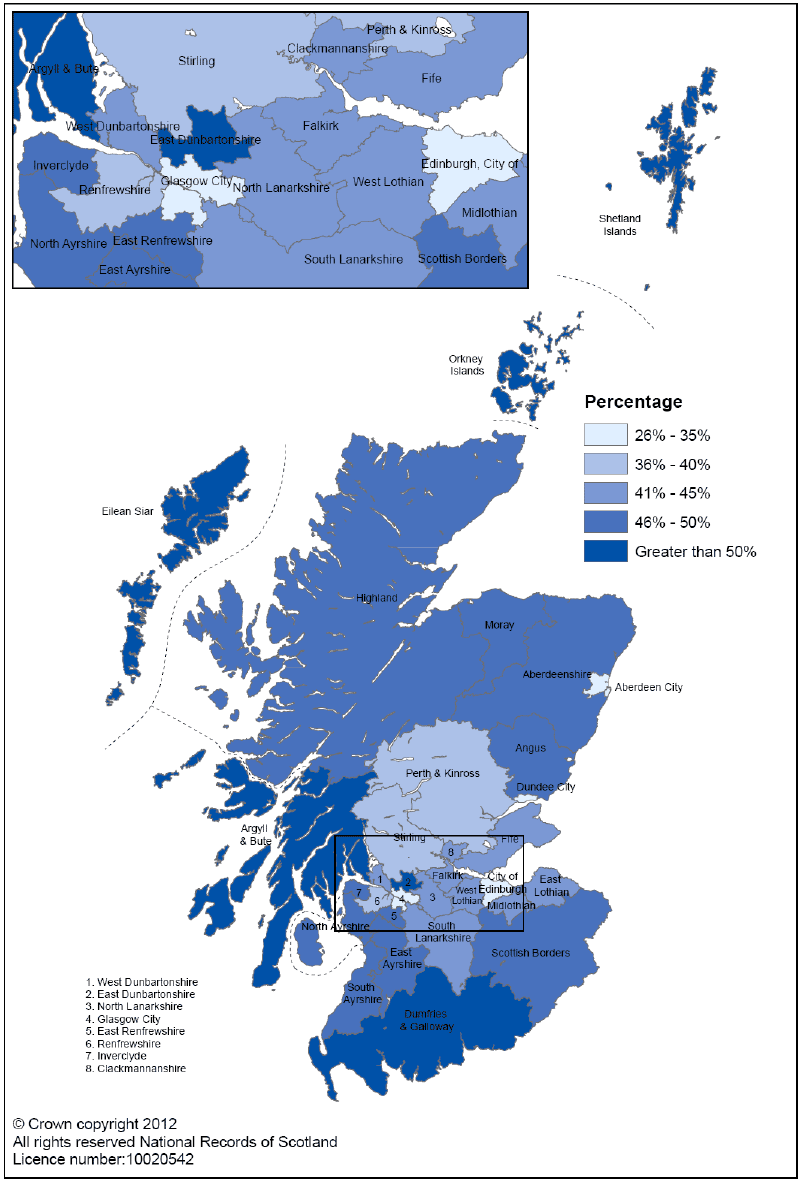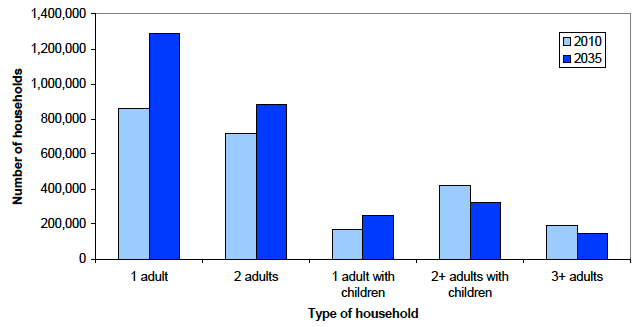
2. Results
2.1 Scotland: Overall number of households
2.1.1 The number of households in Scotland is projected to increase from 2.36 million to 2.89 million between 2010 and 2035, an increase of 23 per cent. The projected yearly increase in the number of households is 21,230. It is higher in the earlier part of the projection period than in the later years. In the first 10 years of the projection period the average annual increase is 23,120 households, compared with 19,980 in the final 15 years of the projection period.
2.1.2 The household projections are affected by the projected trends in the Scottish population. The Scottish population is projected to increase by 10 per cent between 2010 and 2035, with average annual increases in population that are greater at the beginning of the projection period than at the end. This is as a result of the changes in the underlying assumptions about the number of births and deaths and the level of net migration. The increase in the projected population of Scotland contributes to the increase in the projected number of households in Scotland.
2.1.3 The trends in the Scottish population projections do not entirely explain the changes in the household projections, as the household projections increase by a much larger percentage than the population projections. The larger change in the household projections over the projection period is due to more people living alone or in smaller households (Section 2.2). The average household size is projected to decrease from 2.17 in 2010 to 1.95 in 2035. This is the continuation of a long-running decline in average household size. In 1971 the average household size was around three people.
2.1.4 These results can be found in Table 1.
2.2 Scotland: Type of household
2.2.1 As described above, the decline in average household size in Scotland results from more people living alone or in smaller households. Figure 1 shows the projected number of households of each type in 2010 and 2035. There is a large increase in the number of adults living alone, from 863,000 (37 per cent of all households) in 2010 to over 1.29 million (45 per cent) by 2035. Households containing just two adults, without children, are projected to rise from 719,000 to 884,000, although two adult households make up 31 per cent of all households throughout the projection period. Households containing one adult with children are projected to rise from 166,000 households (7 per cent of all households) to 249,000 households (9 per cent).
2.2.2 In contrast to the increases in smaller households, decreases in the numbers of larger households are projected. Households containing two or more adults with children are projected to decrease from 420,000 households (18 per cent of all households) in 2010 to 324,000 household (11 per cent) by 2035. There is also a projected decrease in the number of households containing three or more adults, from 190,000 (eight per cent) to 143,000 (five per cent).
2.2.3 These results can be found in Table 2.
Figure 1: Projected number of households in Scotland by household type, 2010 and 2035

2.3 Scotland: Age of head of household
2.3.1 The population projections show that Scotland's population is ageing, with a projected increase in the number of people in older age groups (65+) of 63 per cent by 2035, while the population of adults in the younger age groups (16-64) decreases by just over one per cent. This difference is reflected in the household projections, with the largest increases shown in households headed by people aged 65 and over (an increase of 58 per cent between 2010 and 2035, from 603,000 to 954,000). In contrast, households headed by someone aged under 65 are projected to increase by just 10 per cent, to around 1.93 million. The number of households headed by someone aged 85 or over is projected to more than double from 76,000 to 198,000 households.
2.3.2 These figures show that while the percentage of households headed by the younger age groups increases, despite the population declining slightly, the percentage of households headed by older age groups increases by slightly less than the increase in population. This is reflected in the average household size for each age group. While older people tend to live in smaller households, with an average household size of 1.40 in 2010, compared to an average household size of 2.44 for those under 65, the average household size shows a small increase (1.8 per cent) over the projection period. This compares to the average household size for the younger age groups which decreases by 10 per cent between 2010 and 2035.
2.3.3 Projected household numbers by age of head of household can be found in Table 3.
Figure 2: Projected number of households in Scotland by age of head of household, 2010 and 2035
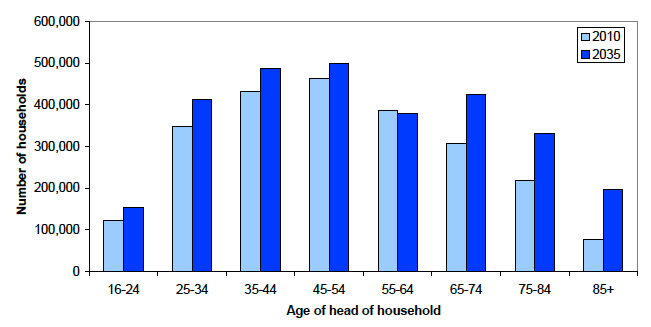
2.4 Scotland: Household type by age of head of household
2.4.1 One adult households: In 2010, 20 per cent of the population aged 16 or over lived alone and this is projected to rise to 27 per cent by 2035. The figures in Table 5 show that people are more likely to live alone as they become older, with 61 per cent of people aged over 85 projected to be living alone in 2035 (up from 56 per cent in 2010). The percentages vary according to gender and age, as illustrated in Figures 3a and 3b. In 2035, in most age groups up to the mid-60s, men are more likely to live alone than women. From the age of 65 onwards, however, women are more likely to live alone, and this likelihood increases with age. This pattern is influenced by women's greater life expectancy, and the tendency of women to marry men who are older than them. In 2035, 77 per cent of women aged 85 or over are projected to live alone compared to 38 per cent of men in the same age group.
2.4.2 The gap between the average life expectancy of men and women in Scotland is decreasing. This means that the number of older men is projected to increase more rapidly than the number of older women, which contributes to the projected increase in the total number of men living alone, from 383,000 households in 2010 to 600,000 in 2035, an increase of 57 per cent. This compares to an increase in the total number of women living alone of 43 per cent to 688,000 over the same period. The number of men living alone who are aged 85 or over is projected to increase from 12,800 to 40,600 (a 216 per cent increase), compared to a 158 per cent increase for women, however the factors described earlier mean that there will still be many more very old women living alone than men (121,000 women aged 85 or over are projected to be living alone by 2035).
2.4.3 The substantial projected increase in the number of older households, and particularly the increase in older people living alone, has implications for services, and policies, aimed at supporting older people.
Figure 3a: Projected percentage of people living alone in 2010, by age and gender
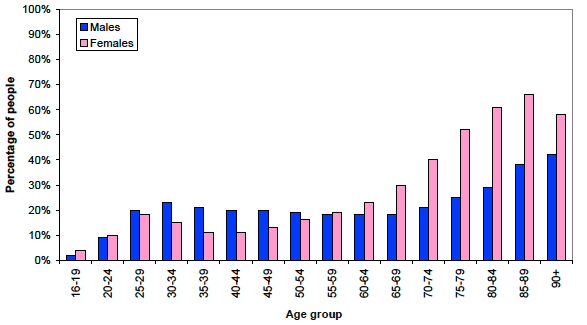
Figure 3b: Projected percentage of people living alone in 2035, by age and gender
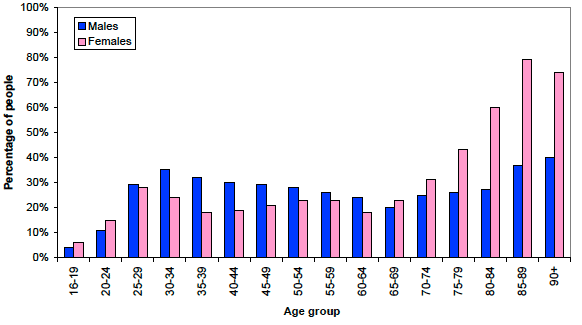
2.4.4 Households containing two or more adults without children: There are large projected increases in the number of households containing two adults without children in the older age groups (65+), which is likely to be linked to the increase in average life expectancy and the narrowing of the gap between the life expectancy of men and women. The number of two adult households headed by someone aged 65 or over is projected to increase by 60 per cent from 245,000 in 2010 to 393,000 in 2035. The number of two adult households which are headed by someone aged 85 or over more than doubles over the same period, to over 30,000 households.
2.4.5 In contrast to two adult households, the number of households with three or more adults is projected to decline in most age groups, except for those aged under 35. Households with three or more adults in these youngest age groups are projected to increase by over 75 per cent from 32,000 in 2010 to 56,000 in 2035.
2.4.6 Households with children: In 2010, seven per cent of all households consisted of one adult living with one or more children, and this is projected to increase to nine per cent in 2035. There are projected increases in the number of households of this type for all ages of head of household, particularly those aged over 30.
2.4.7 In 2010, 18 per cent of all households contained two or more adults with children, a figure that is projected to fall to 11 per cent by 2035. There are reductions in most age groups, with big reductions (over 50 per cent) occurring in the 20-29 age groups, which reflects an increase in the average age at which women have their first child.
2.4.8 Projected household numbers for Scotland, by household type and age of head of household can be found in Table 4 and Figure 4.
Figure 4: Projected number of households in Scotland by household type and age of head of household, 2010 and 2035
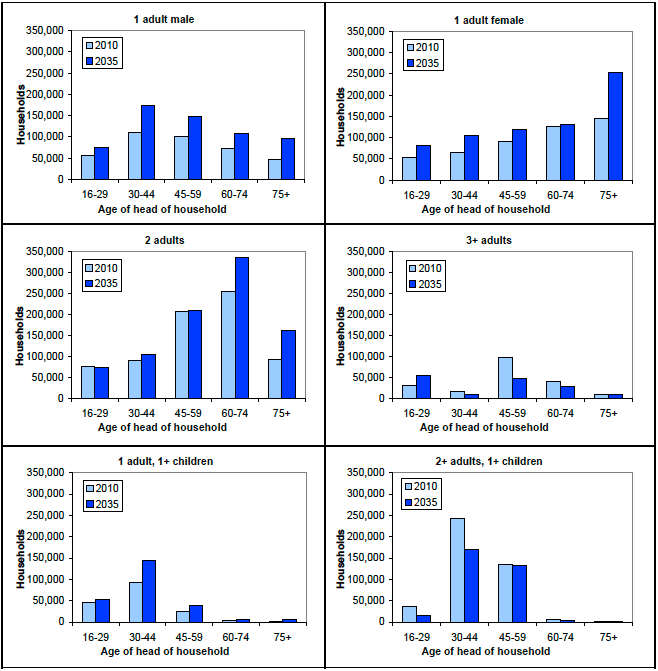
2.5 Local authorities: Overall number of households
2.5.1 Household projections by household type and age group for all 32 local authorities can be found in the detailed local authority tables on the National Records of Scotland (NRS) website. It should be noted that projections for areas with small populations tend to be less reliable than those for areas with larger populations.
2.5.2 The total number of households, by local authority, is presented in Table 6. The number of households in almost every local authority is projected to increase over the projection period. Figure 5a shows the projected number of households in each local authority in 2010 and 2035.
2.5.3 Figure 5b shows the projected percentage change in the number of households between 2010 and 2035. This information is also presented in Map 1. The largest projected increases in the number of households between 2010 and 2035 are in City of Edinburgh (43 per cent), Perth and Kinross (43 per cent), East Lothian (39 per cent) and Aberdeen City (39 per cent). Aberdeenshire, Stirling and West Lothian also have projected increases of 30 per cent or over. In contrast, Inverclyde has a projected decrease of six per cent and four local authorities (Argyll and Bute, Dumfries and Galloway, East Dunbartonshire and West Dunbartonshire) have projected increases of less than five per cent.
2.5.4 These increases in household numbers can be compared to the changes in the projected population for each local authority, between 2010 and 2035 (Footnote 2). These range between -17 per cent for Inverclyde and 33 per cent for East Lothian, with nine additional local authorities projected to experience population decline (Argyll and Bute, Dumfries and Galloway, East Dunbartonshire, East Renfrewshire, Eilean Siar, North Ayrshire, Renfrewshire, South Ayrshire and West Dunbartonshire). Of the authorities that are projected to have a decline in population over the 25 years of the projection, only Inverclyde is projected to experience a decline in household numbers, although the others are only projected to have small increases in household numbers. This difference between the change in the household and population projections is due to individuals choosing to live in smaller households, as discussed for Scotland in Section 2.2.
2.5.5 The average household sizes that are projected for each local authority can be seen in Table 7. The areas with the largest projected average household size in 2035 are East Renfrewshire (2.25) and Aberdeenshire (2.15). The areas with the smallest average household size are the four main city authorities (Aberdeen, Dundee, Edinburgh and Glasgow) and the three island authorities of Eilean Siar, Orkney Islands and Shetland Islands (between 1.76 and 1.88). Map 2 also presents the average household size for each local authority in 2035 and shows that all of the areas with the largest average household sizes (over 2.10) are adjacent to the cities with very low average household sizes, suggesting that there may be some sorting across these areas, where smaller households tend to live within city authorities, but migrate to surrounding local authorities as they grow, for example as people form couples and have children. The average household size is projected to be less than two people for almost two thirds of local authorities by 2035.
Figure 5a: Projected number of households by local authority, 2010 and 2035
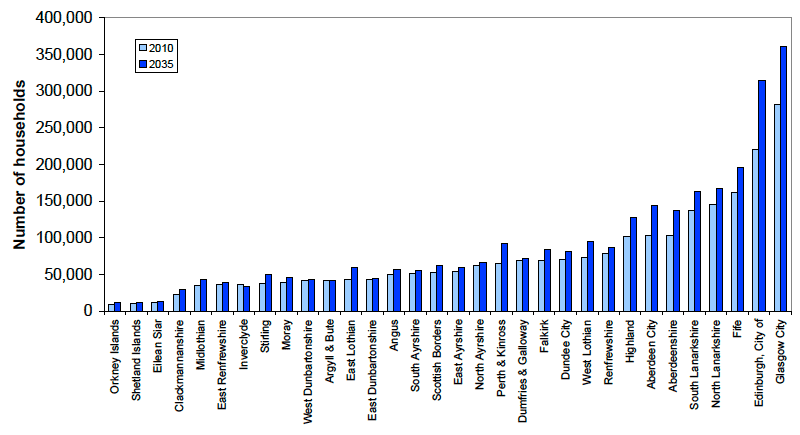
Figure 5b: Projected percentage change in the number of households by local authority, 2010 to 2035
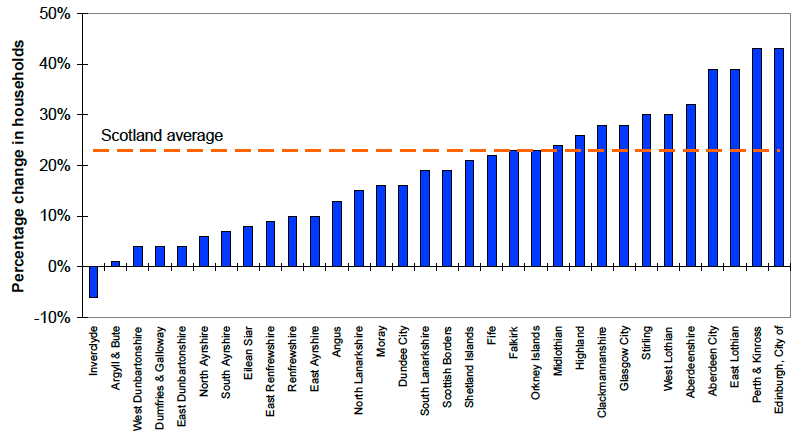
Map 1: Projected percentage change in households between 2010 and 2035, by local authority
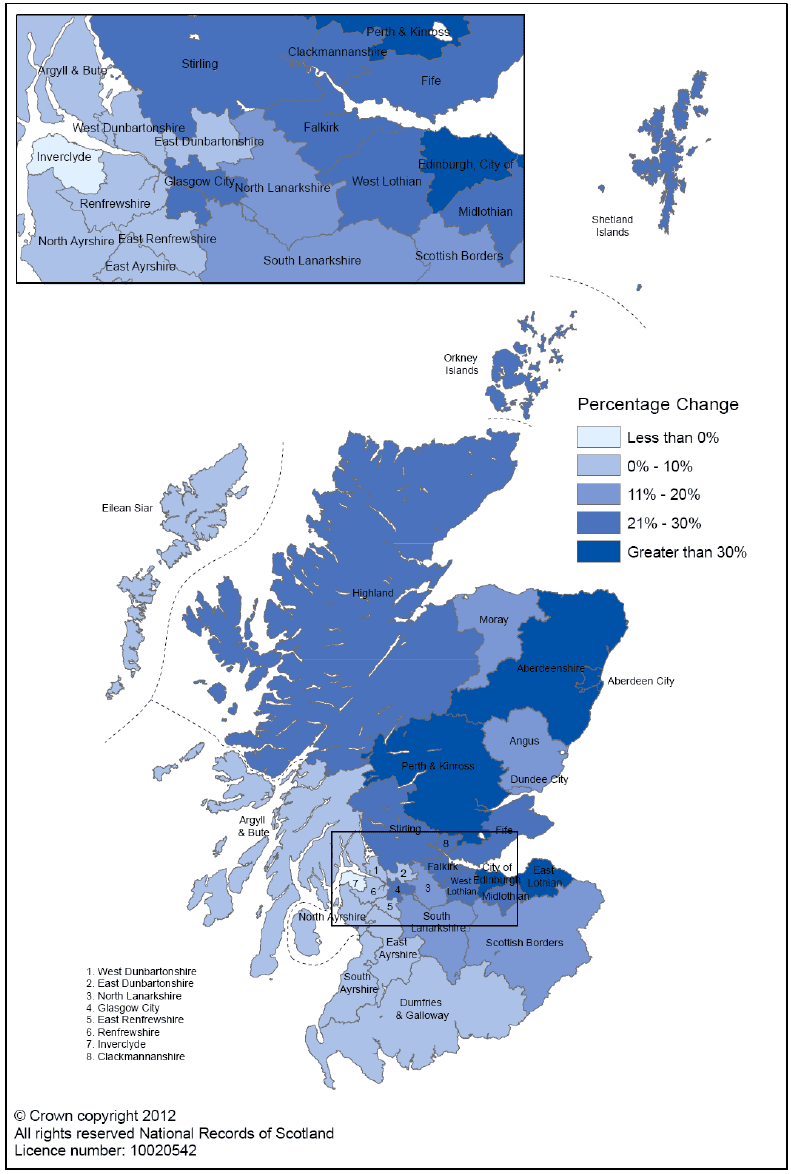
Map 2: Projected average household size by local authority, 2035
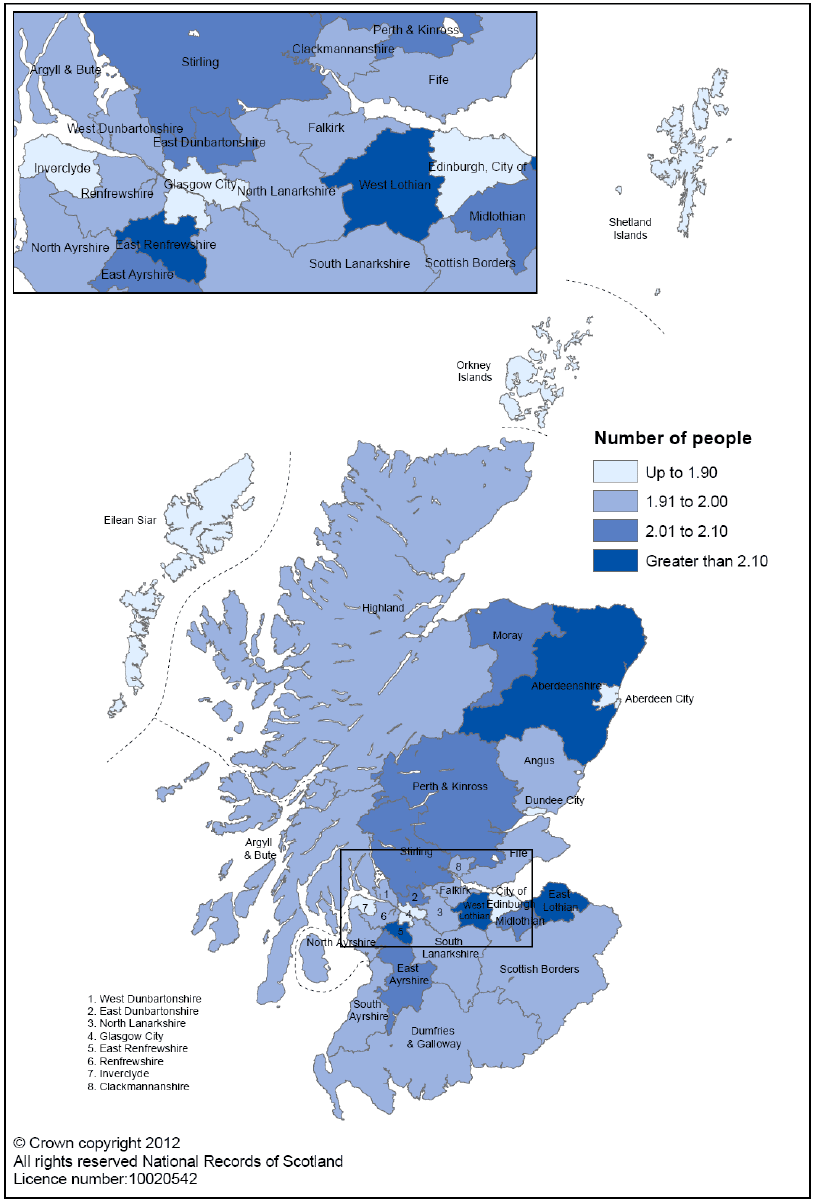
2.6 Local authorities: Type of household
2.6.1 Table 8 shows the percentage of households in each household type for each local authority in 2010 and in 2035.
2.6.2 One adult households (Table 9): Map 3 shows the projected percentage of households which contain just one adult, in each local authority, in 2035. By 2035 over half of the households in Glasgow City and Inverclyde are projected to be single adult households, compared to the Scottish figure of 45 per cent. The lowest percentages of single adult households are found in Aberdeenshire and East Renfrewshire (37 per cent). In every local authority there is a projected increase in the number of people living alone between 2010 and 2035, ranging from an 18 per cent increase in Inverclyde to 71 per cent increases in Aberdeenshire and Perth and Kinross.
2.6.3 Households containing two or more adults without children (Table 10 and Table 11): The proportion of households consisting of two adults but no children in 2035 is projected to vary from 20 per cent in Glasgow City to 41 per cent in the Scottish Borders, as compared to a Scottish figure of 31 per cent. Additionally between two per cent (Scottish Borders) and 10 per cent (City of Edinburgh) of households are projected to consist of three or more adults and no children. There is a projected increase in two adult households between 2010 and 2035 in all local authorities, apart from Inverclyde where there is a four per cent decrease. In contrast, there are projected decreases in three or more adult households in the majority of local authorities. The only local authorities with projected increases in three adult households are the city authorities of Glasgow City (one per cent), Aberdeen City (two per cent), Dundee City (five per cent) and City of Edinburgh (36 per cent).
2.6.4 Households containing children (Table 12 and Table 13): Map 4 shows the projected percentage of households with children (regardless of the number of adults) in each local authority in 2035. In general, it is the local authorities which are reasonably close to the main cities which have the highest percentages of households with children. The figures are lower in the cities themselves, and in the more remote rural areas and island local authorities.
2.6.5 All local authorities are projected to see an increase in the number of households consisting of one adult with one or more children, between 2010 and 2035. The highest percentage increase occurs in East Lothian, where the number of households is projected to more than double, from 2,790 in 2010 to 6,030 in 2035, compared to the projected change of 51 per cent in Scotland as a whole. Glasgow City is projected to have the highest proportion of households of this type in 2035 (12 per cent), followed by Clackmannanshire, Midlothian, North Ayrshire and North Lanarkshire (11 per cent each). The smallest proportions are in Moray and Orkney Islands (three and four per cent of all households, respectively).
2.6.6 The number of households containing two or more adults with children is projected to decrease between 2010 and 2035 in all local authorities except Aberdeen City, East Lothian, City of Edinburgh and Perth and Kinross, which see projected increases of between two and seven per cent. The local authorities with the smallest proportions of these households in 2035 are Eilean Siar (six per cent), Glasgow City (eight per cent) and North Ayrshire (nine per cent).
The local authorities with the highest proportions are projected to be East Lothian and East Renfrewshire, with 16 per cent and 19 per cent respectively, although East Renfrewshire is projected to see a 20 per cent decrease over the projection period.
2.7 Local Authorities: Age of head of household
2.7.1 The percentage of households, in each local authority, headed by different ages of head of household are shown in Table 14, for 2010 and 2035. The numbers of households in each age group, by local authority, can be seen in Tables 15 to 19.
2.7.2 Most local authorities are projected to see an increase in the number of households headed by adults aged 16 to 29 and 30 to 44 (27 and 24 local authorities respectively), but a decrease in the numbers of households headed by adults aged 45 to 59 (25 local authorities). The majority of local authorities (28) also see increases in the number of households headed by those aged 60 to 74. The age group with the largest increase in household numbers is where the head of household is over 75 years of age. In this age group all local authorities are projected to see increases in household numbers. The smallest percentage increases are in Glasgow City (31 per cent) and Dundee City (33 per cent). In contrast, the numbers of households headed by this age group are projected to more than double in Midlothian (a 103 per cent increase), Highland (115 per cent), Clackmannanshire (122 per cent), Orkney Islands (131 per cent), Aberdeenshire (137 per cent), Shetland Islands (141 per cent) and West Lothian (144 per cent).
2.7.3 Map 5 shows the projected percentage of households headed by someone aged 60 and over in 2035. Six local authorities are projected to have over half of their households headed by someone over 60 by 2035. These local authorities include the three island authorities, East Dunbartonshire, Argyll and Bute and Dumfries and Galloway, with Eilean Siar projected to have 59 per cent of its households headed by someone aged 60 and over by 2035. The smallest percentages of these households are in the four city authorities (27 to 33 per cent).
Map 3: Projected percentage of households containing one adult with no children by local authority, 2035
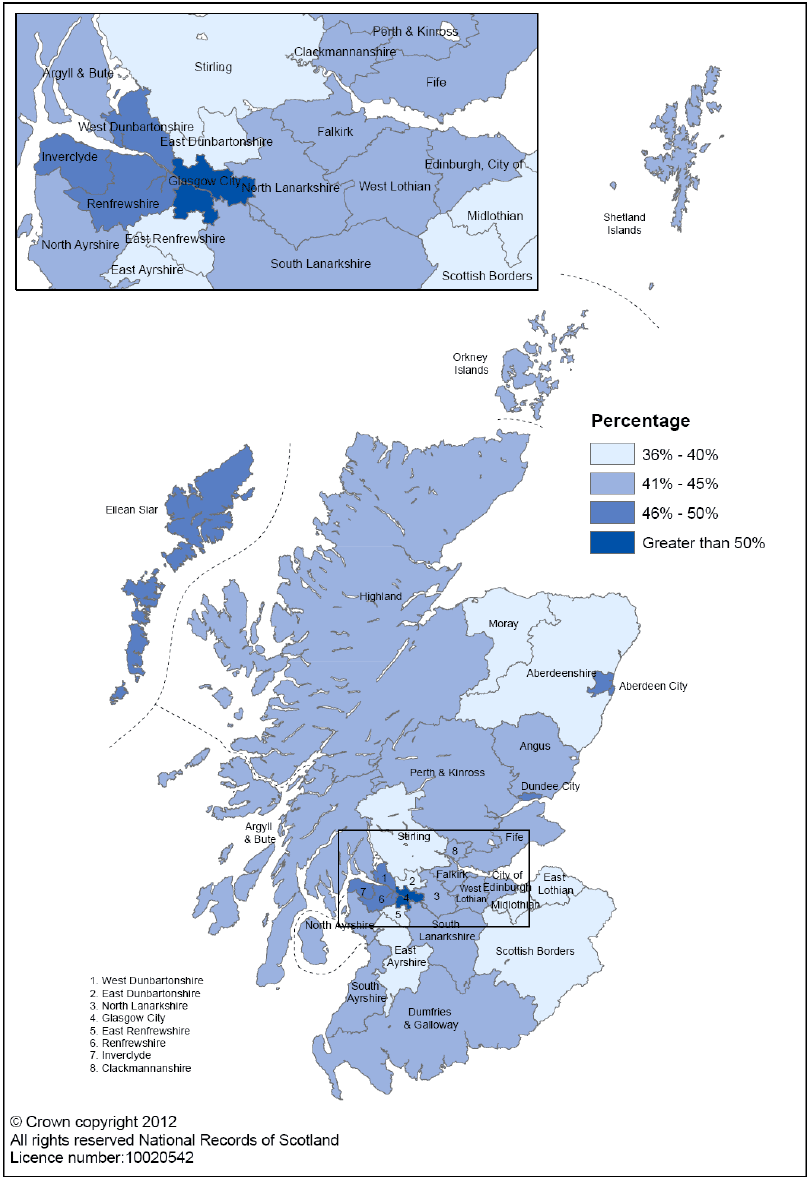
Map 4: Projected percentage of households with children by local authority, 2035
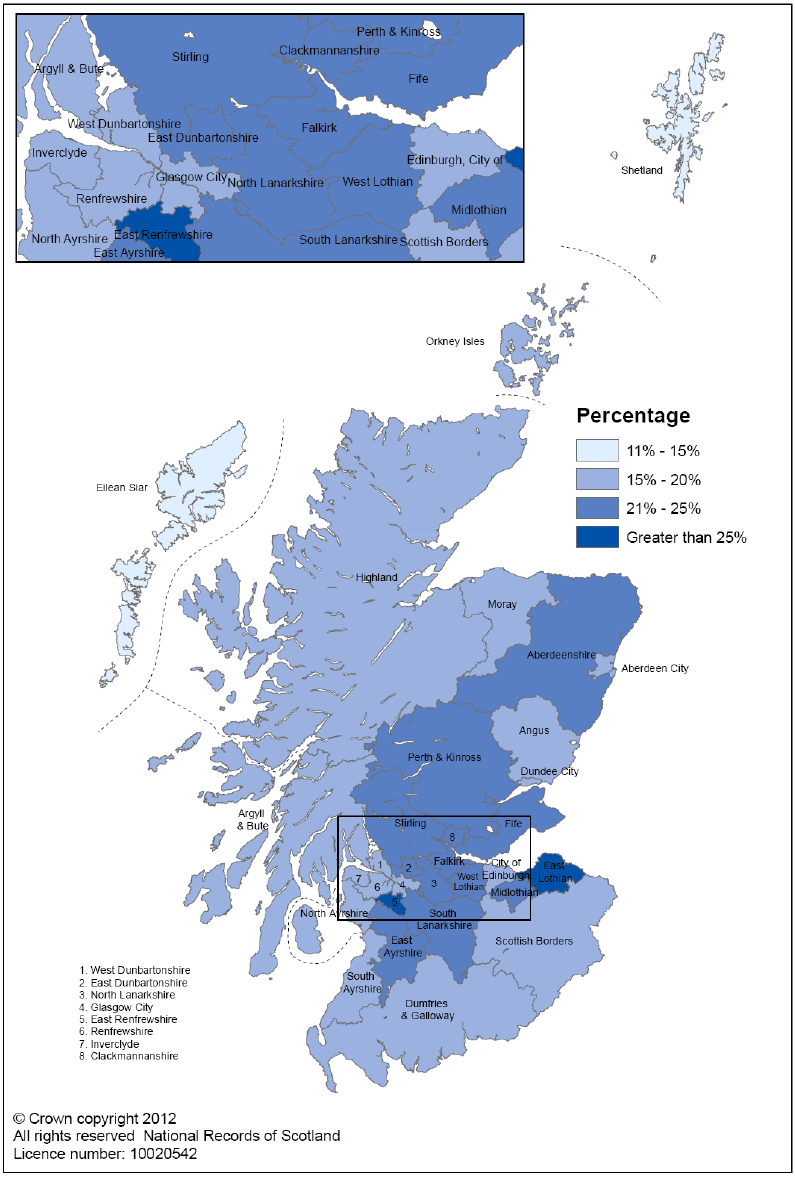
Map 5: Projected percentage of households headed by someone aged 60 and over by local authority, 2035
